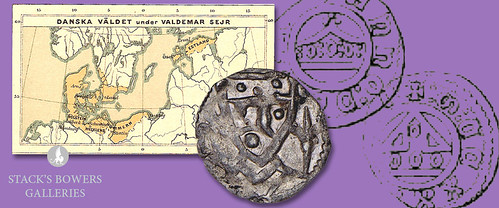
PREV ARTICLE
NEXT ARTICLE
FULL ISSUE
PREV FULL ISSUE
FIRST COMMON ERA DATE ON A COIN IS 1234Here's an interesting numismatic tidbit from a Stack's Bowers blog article by Chris Bulfinch. -Editor Ancient and earlier medieval coins are often dated by regnal year, not by year-dates of the Julian/Gregorian calendar. The practice of applying Common Era dates to coinage began in the thirteenth century, with the first Common Era date borne by a coin being 1234, applied to a bronze coin struck in Denmark under the reign of Valdemar II. This bronze coin has the date in Roman numerals on the reverse. Seven examples are known, one of which resides in private hands. That the first Common Era date featured on a coin is composed of ascending digits is certainly interesting.
Another coin struck in the early thirteenth century which could plausibly claim the moniker of Blog readers are encouraged to check out Robert A. Levinson's The Early Dated Coins of Europe, 1234-1500. A useful CoinsWeekly piece on the issue: https://coinsweekly.com/two-contenders-for-the-first-christian-era-dated-coin/
To read the complete article, see:
Wayne Homren, Editor The Numismatic Bibliomania Society is a non-profit organization promoting numismatic literature. See our web site at coinbooks.org. To submit items for publication in The E-Sylum, write to the Editor at this address: whomren@gmail.com To subscribe go to: https://my.binhost.com/lists/listinfo/esylum All Rights Reserved. NBS Home Page Contact the NBS webmaster 
|

